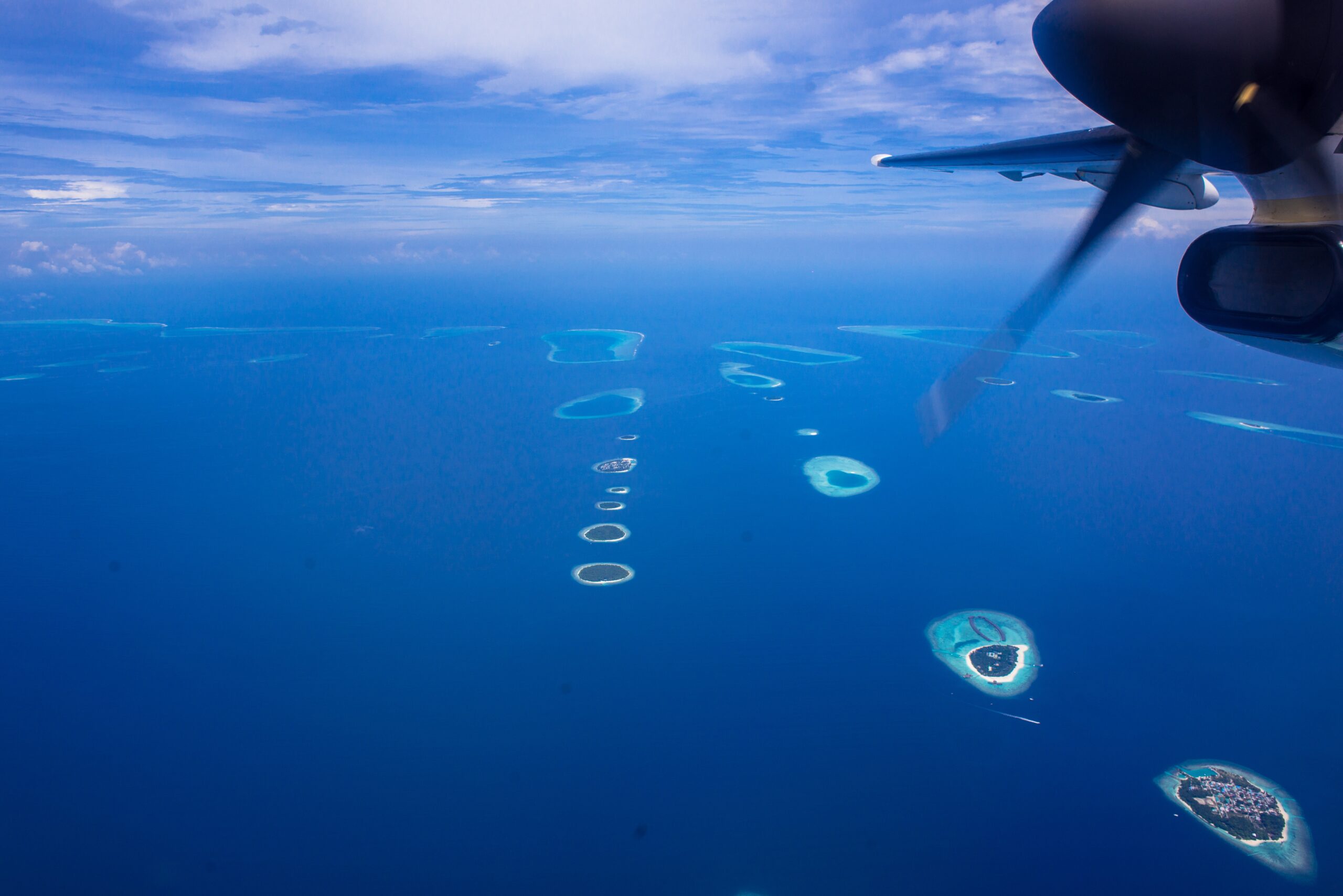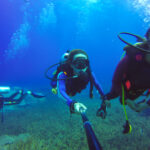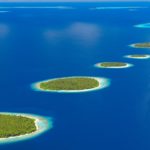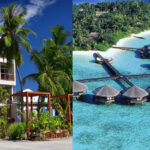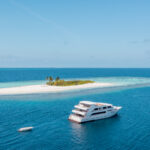The Maldives, chain of 26 atolls and over 1,000 coral islands, is a dream destination for many travelers. Reaching Maldives, as well as navigating its azure waters can be an adventure in itself.
Planning your travel to and within the Maldives might seem daunting at first due to its unique geographical composition. Still, with a bit of understanding and guidance, you can effortlessly plan your journey and soak in all the wonders that this tropical paradise has to offer.
This guide sheds light on the critical question How can I get to the Maldives? and getting around once you’re there, ensuring your trip is as smooth and enjoyable as possible.
Understanding the Maldives
Geography and Importance of Transportation
The Maldives is composed of dispersed islands, making the choice of transportation a key aspect of any travel plan. The Maldives extends over approximately 90,000 square kilometers, so it is one of the most dispersed countries globally.
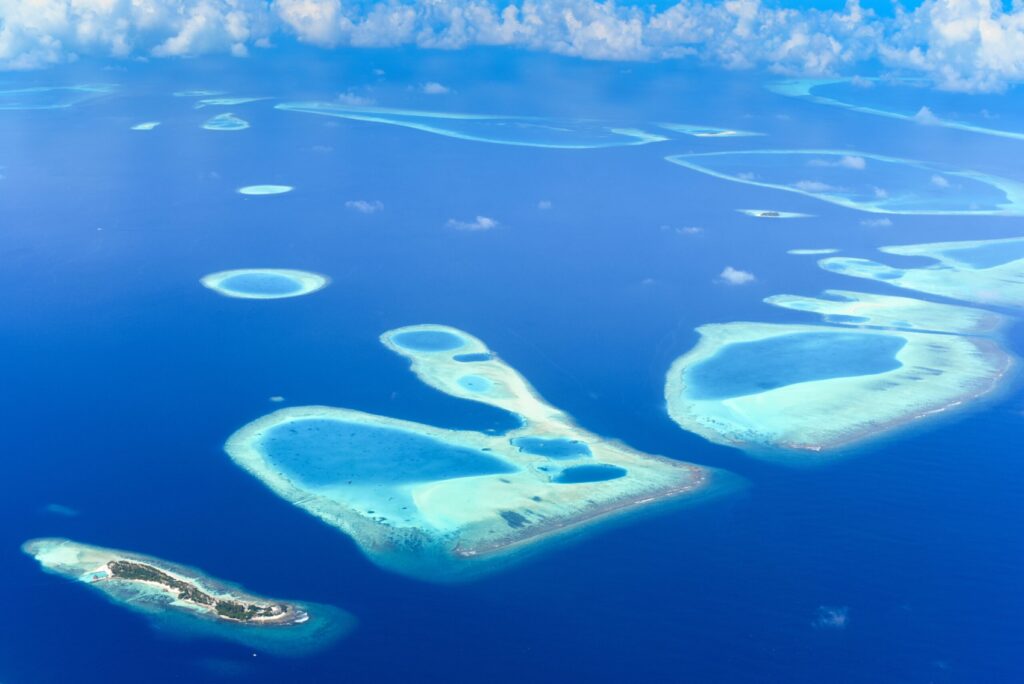
Expansive geography is where the country’s beauty lies. Each atoll, each island holds its unique charm and allure, and the journey between them becomes as thrilling as the destination itself. Understanding the country’s unique geography is the first step in efficiently planning your journey.
The Maldives is broadly divided into 19 administrative atolls, along with the capital city, Malé. These atolls are grouped into the North and South provinces for administrative purposes. Each atoll is a cluster of numerous islands. Some of these islands are developed into resorts, some are inhabited with local populations, and many remain uninhabited, pristine, and untouched.
The vast ocean that surrounds these islands makes transportation an intriguing aspect of your Maldivian adventure. Depending on the distance, you could be boarding a domestic flight, hopping onto a speedboat, or even taking a leisurely ferry ride to get from one point to another. Understanding the Maldivian transportation system will help you make the most of your time in this island paradise.
Key Points of Entry
There are a few key points of entry for international visitors that act as gateways to paradise. Primarily, the Velana International Airport, located in Hulhulé Island near the capital city, Malé, serves as the main entrance to the country.
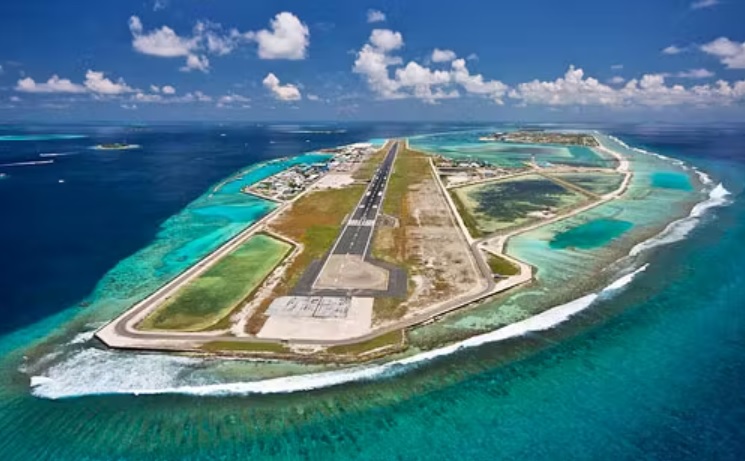
Velana International Airport connects the Maldives to major global cities via various international airlines. Upon landing, you would either take a domestic flight, a seaplane, or a speedboat to reach your chosen resort or local island, depending on the distance
Some of the far-flung atolls also have international airports, such as Gan International Airport in Addu Atoll, which can also serve as an entry point if you’re planning to explore the southern reaches of the Maldives.
With this understanding of the Maldives’ geography and entry points, you’re already one step closer to your dream holiday. Next, we will delve deeper into each transportation mode, flight information, and visa requirements to equip you with all the necessary information and tips for a hassle-free Maldivian escapade.
How can I get to the Maldives?
Flight Information
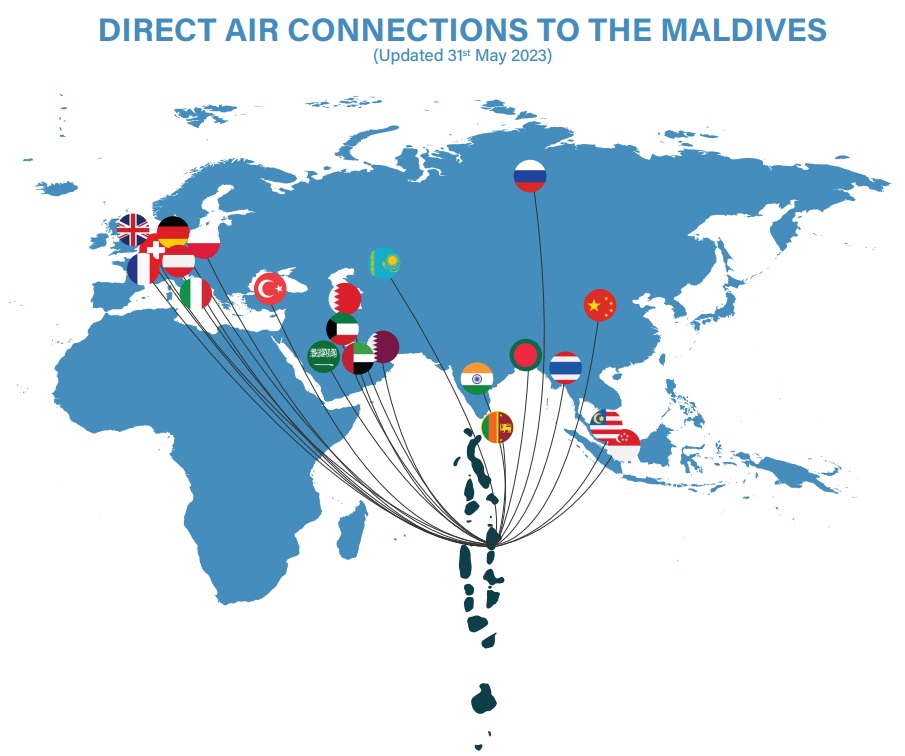
The Maldives is served by a multitude of airlines, connecting this island paradise to various parts of the globe. Being a popular holiday destination, it boasts excellent air connectivity with most major cities around the world. Major airlines that frequently fly to the Maldives include Emirates, Singapore Airlines, Qatar Airways, and Turkish Airlines among others.
Emirates offers flights from many cities via their hub in Dubai. Similarly, Qatar Airways connects through Doha, and Singapore Airlines, through Singapore. Turkish Airlines offers another good option via Istanbul. If you’re traveling from Asia, then airlines like Air India, Sri Lankan Airlines, and Cathay Pacific also provide regular services.
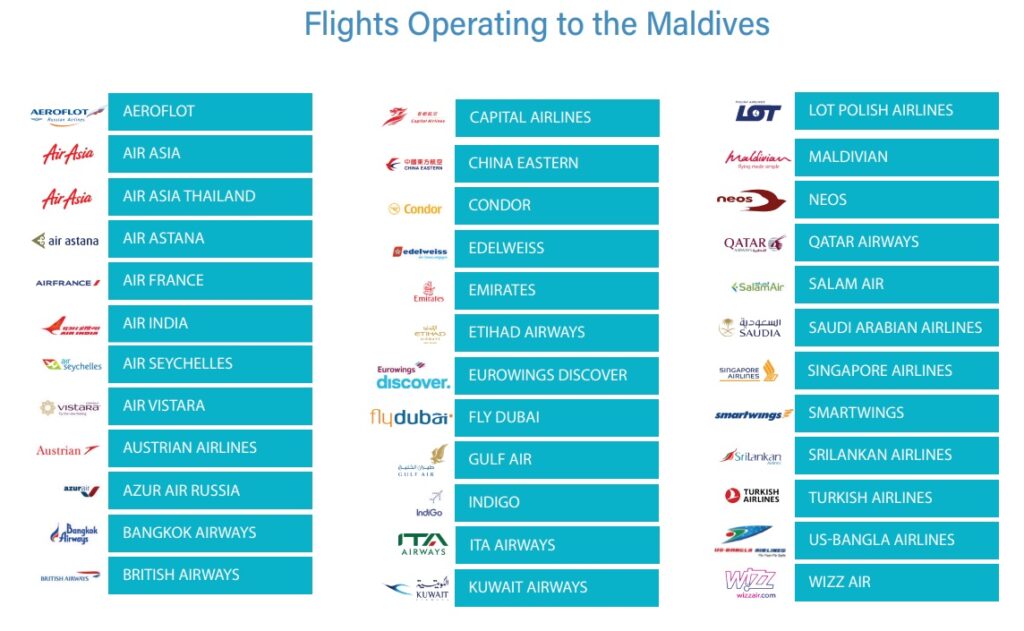
Flight durations vary based on your location. If you’re coming from Europe or the Americas, you should anticipate long-haul flights, often with one or two stopovers. From Asia, Australia, and the Middle East, flights are comparatively shorter and might even offer direct routes.
There are also charter flights during the high season from various parts of the world. So depending on origin, it is best to compare the prices of different airlines to get the best deal.
Keep in mind, the main international airport in the Maldives is Velana International Airport (MLE), situated near Malé. Most international flights land here. Upon arrival, you can soak in your first glimpse of the country’s stunning atolls and azure waters as the airport itself is located on an island.
Visa Information
Entry into the Maldives is generally a smooth process, with visas usually issued upon arrival for tourists. This free tourist visa is valid for 30 days. You must have a valid passport, and it is advised to have a return ticket to prove your intention of leaving the country within the stipulated period. You will also need to fill in a immigration before your arrival and departure.
While the visa-upon-arrival system makes the Maldives an easily accessible destination, it’s crucial to remember that immigration requirements can vary, and they are subject to change. It is always recommended to check the current visa policies before your departure. You can do this by visiting the official Maldives Immigration website or contacting the nearest Maldivian embassy or consulate.
Also, if you plan on staying for longer than 30 days, you need to extend your visa, which is subject to approval by the immigration authorities. It is recommended to avoid overstaying your visa as it could result in fines or other legal complications.
Health and Safety Considerations
While the excitement of visiting the Maldives is palpable, it’s important to stay up-to-date on any travel advisories or health and safety considerations before your trip.
The Maldives does not require any specific vaccinations for entry. However, it’s advisable to have routine vaccinations up to date, and depending on your specific travel plans, vaccines for Hepatitis A and Typhoid might also be recommended.
Pandemic-related travel rules may vary. Always check the latest travel advice from reliable sources like the World Health Organization (WHO), your local health department, or the Maldivian Ministry of Health.
It’s important to ensure you have appropriate travel insurance that covers medical expenses. Although the Maldives is a safe country, having travel insurance will help provide peace of mind during your trip.
Lastly, don’t forget to pack all your essential medications along with their original prescriptions. It’s also a good idea to carry a basic first-aid kit with essentials like band-aids, antiseptic creams, and pain relievers.
Getting Around in the Maldives
Domestic Flights
When it comes to internal transport within the Maldives, domestic flights serve as a quick and efficient means to reach distant atolls. Maldivian, the national carrier of the Maldives, operates regular domestic flights to various parts of the country.
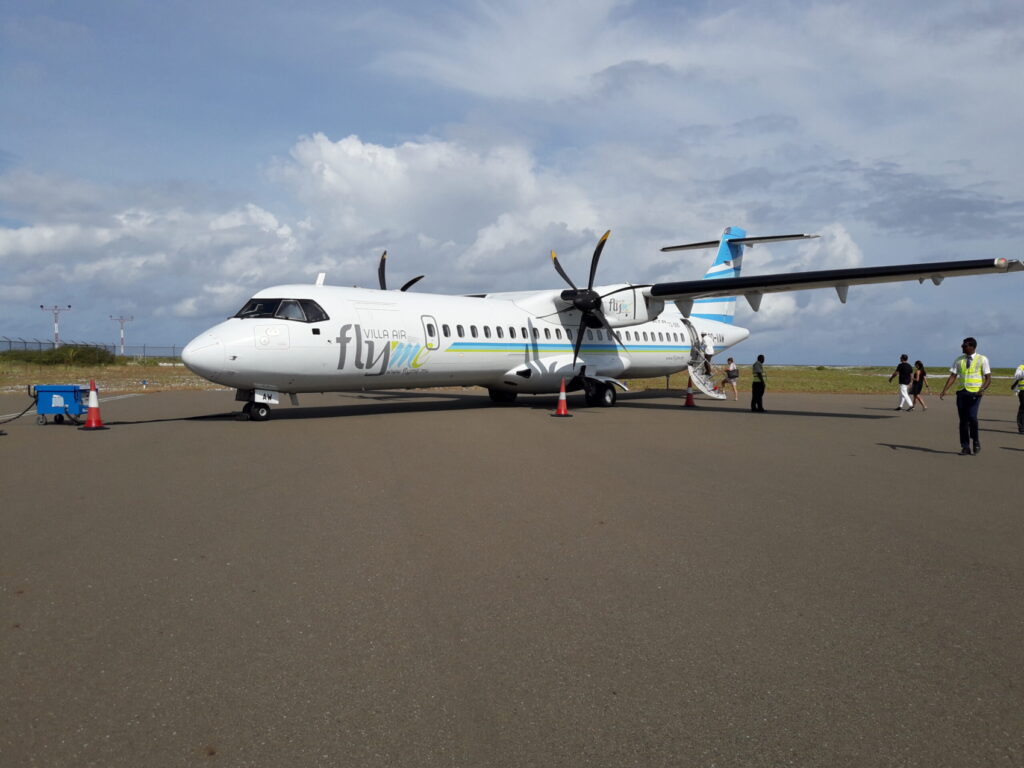
These flights are generally from Malé, where the main international airport is located, to domestic airports situated on different atolls. If your chosen resort or local island is far from Malé, the resort or guesthouse often arranges a domestic flight for you.
A domestic flight in the Maldives offers a unique perspective of the country’s topography. From above, the atolls appear as stunning lagoons surrounded by turquoise waters, making the flight itself a breathtaking experience. A significant advantage of domestic flights is their scheduling throughout the day, offering flexibility in case of international flight delays.
However, domestic flights may not be the best choice if your destination is close to Malé, as a speedboat or ferry could be quicker and more cost-effective. Also, keep in mind that domestic flights, while reliable, can sometimes be delayed due to unpredictable weather conditions in the tropics.
Seaplanes
Seaplanes, also known as air taxis, are another popular mode of transport within the Maldives, particularly for resorts that are remote but not too far for a domestic flight. A seaplane ride is an experience to remember with the Maldivian atolls’ scenic beauty providing a stunning backdrop. The aircrafts usually have large windows, allowing passengers to marvel at the view below.
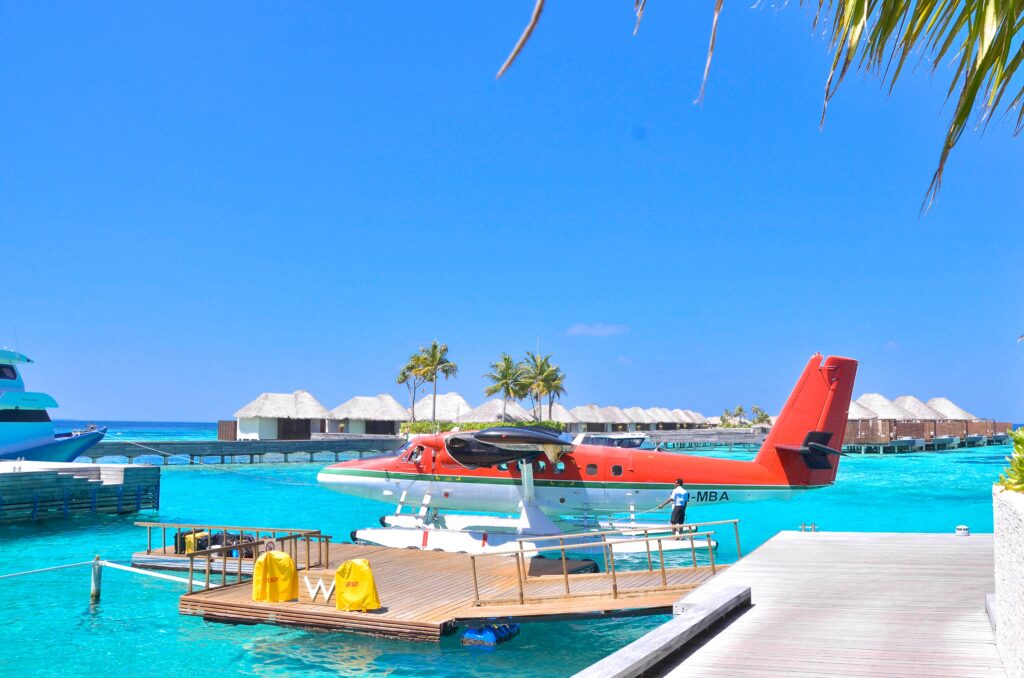
Seaplanes are generally quicker than speedboats and provide a unique advantage of landing directly at the resort’s doorstep. Trans Maldivian Airways (TMA) and Maldivian operate most of the seaplane services in the Maldives.
However, it’s worth noting that seaplane transfers are generally more expensive than other means of transport. Also, they operate only during daylight hours, which could affect your travel if your international flights arrive late in the evening or depart early morning. In this case, you might need to arrange an overnight stay in Malé or a nearby island.
Speedboats
Speedboats are a common and efficient mode of transport for resorts or local islands closer to Malé. They are quick, comfortable, and generally operate round the clock, unlike seaplanes. This is particularly useful if your international flight schedule doesn’t align with the daytime operations of seaplanes.
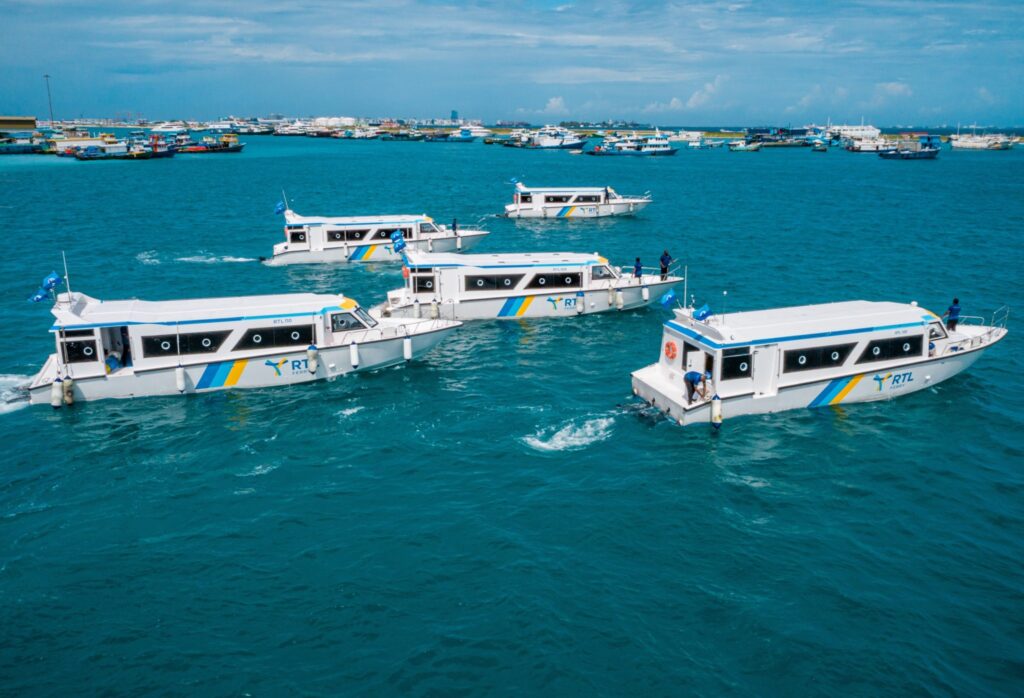
Speedboat transfers are often arranged directly by your resort or guesthouse and are usually combined with other guests to make the journey more cost-effective. Some resorts even offer private speedboat transfers for a more luxurious experience.
The duration of speedboat transfers can range from 20 minutes to a few hours, depending on the distance of your destination from Malé. Although they offer convenience and flexibility, speedboat transfers can sometimes be rough due to sea conditions, so it’s best to be prepared if you’re prone to seasickness.
Ferries and Dhonis
For a truly local experience, taking a ferry or a traditional Maldivian dhoni could be an exciting way to travel between islands, especially within the same atoll. Public ferries operate regular schedules between Malé and nearby local islands. They are a cost-effective mode of transport and give you a chance to mingle with locals.
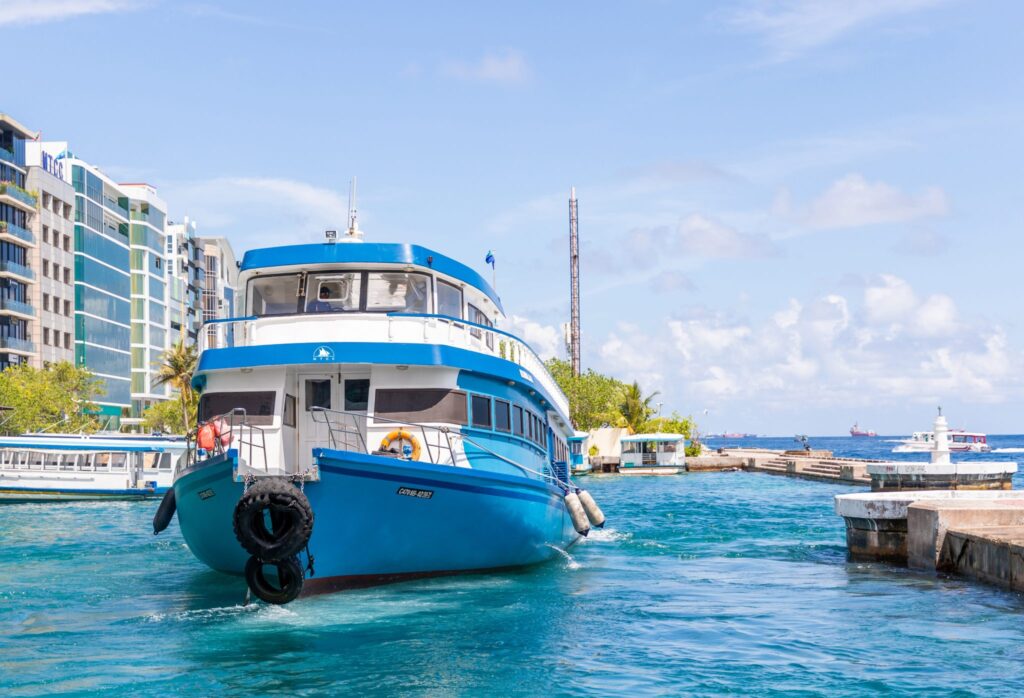
The local ferry network is quite extensive and connects even the furthest atolls, although the journey can be long. If you’re not in a rush and wish to savor the Maldivian seascape at a leisurely pace, a ferry ride could be an enjoyable experience.
It’s important to note that local ferries don’t operate on Fridays, which is a weekly holiday in the Maldives.
Navigating the Maldives: Practical Tips and Things to Keep in Mind
Accommodation Transfers
When planning your trip, bear in mind that transportation in the Maldives is unique due to its geographical setup. Unlike other destinations where you could rent a car or use public transport to reach your accommodation, in the Maldives, you will often need to rely on your chosen resort or guesthouse to arrange your transfer.
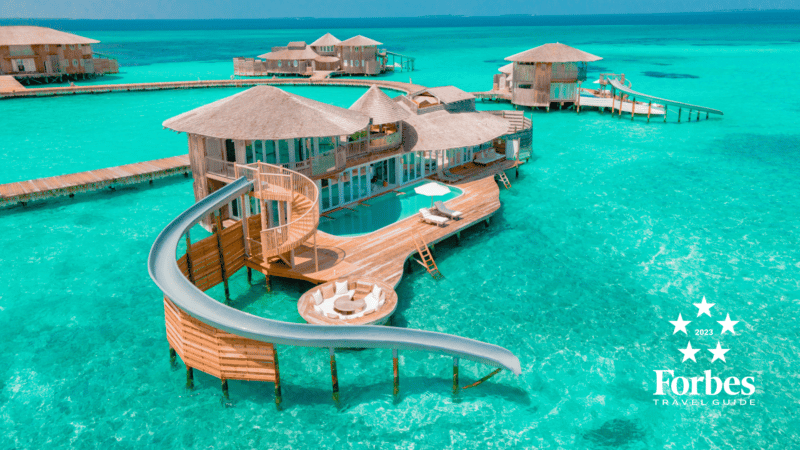
Most resorts include round-trip transfers from Malé to the resort island in their package and take responsibility for coordinating your journey, be it by speedboat, domestic flight, or seaplane. This is why it’s important to provide your arrival and departure flight details to your accommodation provider well in advance, so they can arrange the necessary transfers.
If you’re staying at a local guesthouse, they can usually assist in arranging transport as well. Whether you’re taking a public ferry, speedboat, or domestic flight, always ensure you have a confirmed reservation to avoid any last-minute hassles.
Transportation Costs
The cost of transportation within the Maldives can vary widely, depending on the distance of your destination from Malé and the mode of transport. While public ferries are the most budget-friendly option, they can be time-consuming and may not serve all islands.
Speedboats and domestic flights offer a balance between cost and convenience, but they can still be quite expensive, especially for long distances. Seaplane transfers, while providing a breathtaking experience, are the most costly option.
It’s crucial to factor in these transport costs while planning your trip budget. Also, remember that all prices in the Maldives are generally quoted in US Dollars, and it is the most widely accepted currency, besides the local Maldivian Rufiyaa.
Schedules and Timing
The Maldives follows Maldivian Standard Time (MST), which is GMT+5. However, some resorts have their own island time, which could be an hour ahead of MST, to allow for longer daylight hours. It’s essential to be aware of this difference to plan your transfers and activities accordingly.
Seaplanes operate only during daylight hours for safety reasons, usually between 6:00 AM and 4:00 PM. This could impact your plans if your international flight arrives late or departs early. In such cases, you might need to stay overnight in Malé or Hulhumalé.
Speedboats, on the other hand, operate round the clock, making them a more flexible option. Public ferries have set schedules, usually running multiple times a day, but they don’t operate on Fridays.
Packing and Preparation
When preparing for your trip, remember that the Maldives is a tropical destination. Light, breathable clothing is a must. Also, don’t forget essentials like swimwear, sunscreen, hats, and sunglasses. While the Maldives enjoys a warm tropical climate year-round, it can occasionally rain, especially during the monsoon season between May and November, so packing a light rain jacket or umbrella could be useful.
Lastly, note that the Maldives is a Muslim country, and local customs should be respected. This means dressing modestly when visiting local islands, including Malé. Swimwear is acceptable on resort islands and private tourist beaches, but not on public beaches on local islands.
By keeping these tips and considerations in mind, you can ensure a seamless journey to and within the Maldives, leaving you free to enjoy the breathtaking beauty and tranquility that this tropical paradise has to offer.
Delving Deeper: The Allure of the Maldives
The Maldives is a dream destination for many. The allure of the Maldives lies not just in its postcard-perfect beaches and crystal-clear waters, but also in the unique experiences it offers.
Underwater Adventures
The Maldives is renowned for its incredible underwater world. Home to a diverse marine life, it offers some of the best diving and snorkeling experiences in the world. Vibrant coral reefs teem with a variety of sea creatures, from colorful fishes and turtles to manta rays and reef sharks. And one of the best ways to explore this underwater wonderland is via a liveaboard.
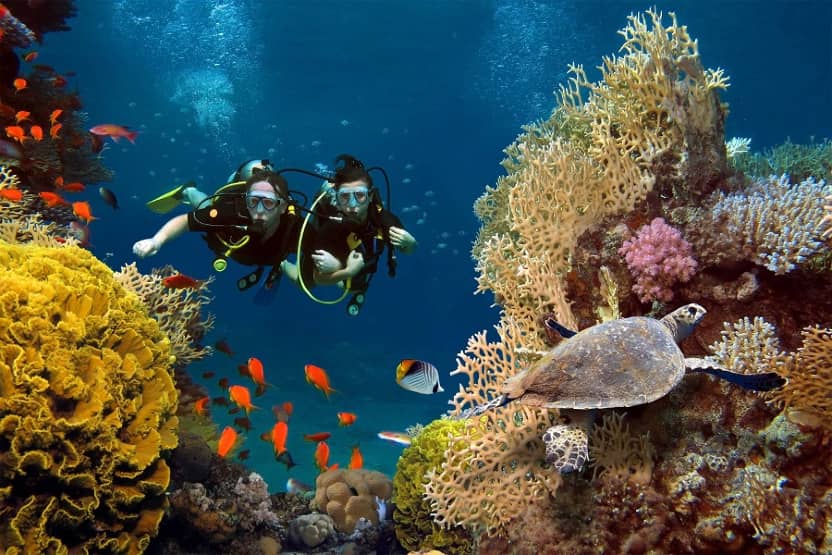
Resorts often have their own house reef, providing easy access for snorkeling. Diving excursions and courses are also widely available, catering to beginners and experienced divers alike. For a truly unique experience, consider a night dive or snorkel, when nocturnal marine creatures come to life.
Remember to respect the underwater environment. Avoid touching or stepping on the coral, and never chase or feed marine animals.
Island Hopping
Another exciting way to explore the Maldives is by going on an island-hopping tour. This allows you to experience the local culture and lifestyle, beyond the resort islands.
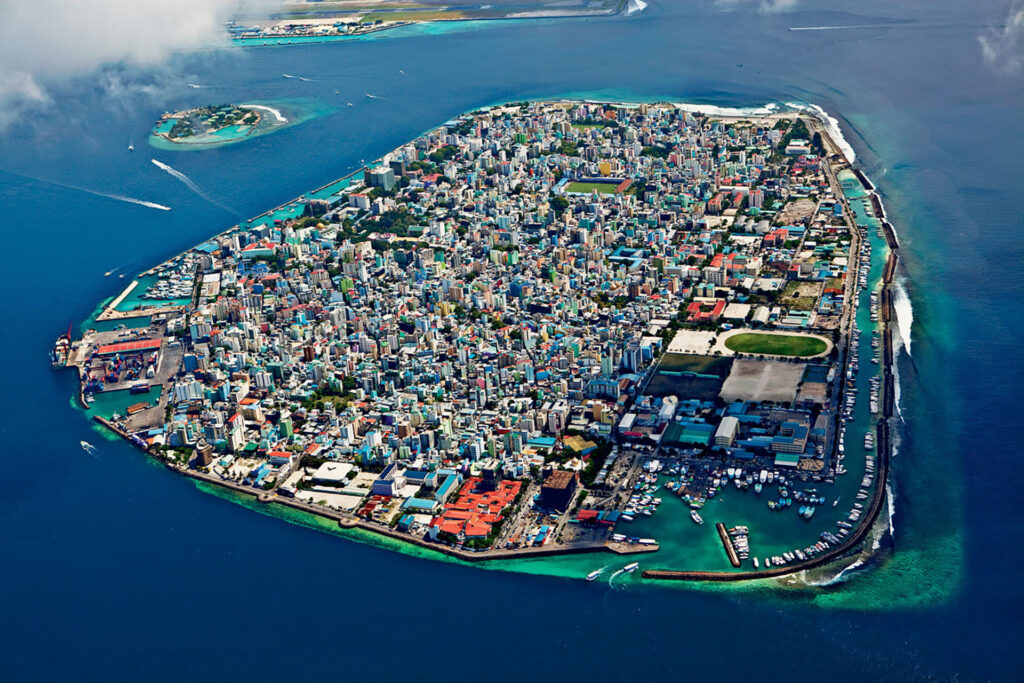
Malé, the capital city, is a bustling hub where you can visit local markets, historic mosques, and museums. You can also visit local islands like Maafushi, Hulhumalé, or Dhigurah to see how Maldivians live. Some local islands also have guesthouses if you wish to stay overnight.
On your island-hopping journey, you might also want to stop by a deserted island or a sandbank. It’s a surreal experience to be on a tiny island in the middle of the ocean, with nothing but azure waters around you. These trips are often combined with a picnic or a barbecue, making for a perfect day out.
Unique Dining Experiences
The Maldives also offers unique dining experiences. From private beach dinners under the stars to underwater restaurants, there’s something for everyone.
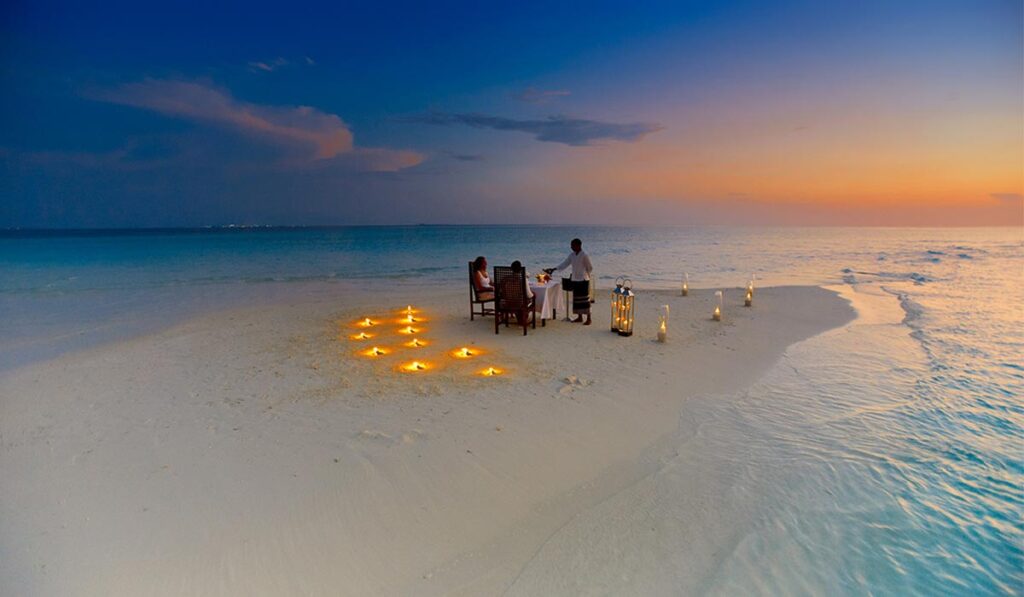
Many resorts offer the opportunity to dine on the beach, with the sand between your toes and the sound of the waves accompanying your meal. Some even have underwater restaurants, where you can dine while watching the marine life through glass walls.
The Maldivian cuisine itself is worth trying. With a rich bounty of seafood, tropical fruits, and the influence of nearby countries, the local food is both diverse and delicious. Try dishes like Garudhiya (fish soup), Mas Huni (shredded smoked fish with coconut), or Bis Keemiya (pastry filled with tuna or vegetables). Don’t forget to enjoy some fresh coconut water, a staple drink in the Maldives.
A World of Wellness
The Maldives is also known for its wellness retreats, with most resorts boasting a spa. Imagine having a massage or a yoga session in a tranquil setting, surrounded by stunning natural beauty.
Many spas incorporate traditional Maldivian healing methods into their treatments, using local ingredients like coconut oil, sea salt, and aloe vera. From beachside pavilions to overwater treatment rooms, these spas offer ultimate relaxation and rejuvenation.
Tourism and Local Customs
Tourism in the Maldives is carefully managed to maintain a balance between catering to tourists and respecting local customs and the environment. Resort islands operate much like international holiday destinations, with a relaxed approach to dress code and availability of alcohol. On the other hand, local laws and customs are strictly followed on inhabited local islands. Here, modest clothing is required, and alcohol is not permitted.
It’s essential to be aware of and respect these differences. The Maldives is a Muslim country, and Islam greatly influences its culture and traditions.
Frequently Asked Questions
- Is it safe to travel to the Maldives?
Absolutely. The Maldives is considered a safe destination for travelers. However, like with any travel, it’s important to take general precautions. Keep your belongings secure, be aware of your surroundings, and respect local laws and customs. Resorts and local islands are used to hosting tourists, so you will find them welcoming and helpful.
2. Do I need a visa to travel to the Maldives?
All tourists receive a 30-day free on-arrival visa in the Maldives. However, you must have a valid passport, enough funds to cover your stay (or a confirmed reservation), and a confirmed return ticket. Visa rules can change, so it’s best to check the latest information from an official Maldivian consulate or embassy before you travel.
3.What’s the best time to visit the Maldives?
The Maldives has a tropical climate, which means warm temperatures year-round. However, there are two main seasons – the dry season (November to April), which sees less rain and more sun, and the wet season (May to October), characterized by occasional rain showers and stronger winds. The dry season, particularly between December and March, is generally considered the best time to visit for beach holidays and water sports.
4. Can I visit local islands in the Maldives?
Yes, you can. Visiting local islands gives you a chance to experience Maldivian culture and lifestyle beyond the resort islands. Note that local customs must be respected on these islands. This includes dressing modestly (shoulders and knees should be covered) and refraining from alcohol, which is not allowed on local islands. Some local islands, like Maafushi and Dhigurah, also have guesthouses for tourists who wish to stay overnight.
5. What should I pack for a trip to the Maldives?
When packing for the Maldives, think tropical beach holiday. Swimwear, beach cover-ups, shorts, t-shirts, sundresses, flip-flops, and a hat for sun protection are essentials. Also, pack enough sunscreen, sunglasses, and a reusable water bottle. Evenings can be casual, but you may want to dress up a bit for dinner, especially if you plan to dine at a fancy restaurant. If you plan to visit a local island, bring modest clothing that covers your shoulders and knees. For diving or snorkeling, you can usually rent equipment, but you might want to bring your own mask and snorkel for a better fit.
6. Can I use my credit card in the Maldives?
Major credit cards are widely accepted at resorts, hotels, and many guesthouses in the Maldives. However, on local islands and smaller establishments, cash might be the only option. ATMs are available in Malé and on some local islands. The currency of the Maldives is the Maldivian Rufiyaa, but US dollars are commonly used, especially in the tourism industry.
7. Is Wi-Fi available in the Maldives?
Yes, most resorts, hotels, and guesthouses in the Maldives offer Wi-Fi. It’s usually free in public areas, but there might be a charge for Wi-Fi in your room or for higher speeds. The quality of the internet can vary, especially on more remote islands. If staying connected is important to you, consider getting a local SIM card with data when you arrive at the Malé airport.
8. Is the Maldives suitable for families?
Definitely. The Maldives is not just for honeymooners or couples; it’s also a fantastic destination for families. Many resorts cater to families with child-friendly accommodations, kids

